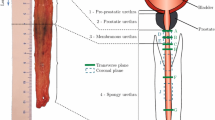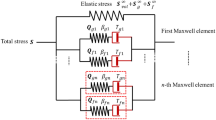Abstract
Purpose
To evaluate the viscoelastic properties of the fresh porcine ureter. Prove the QLV theory can sufficiently model the stress relaxation function of porcine ureters, and determine the QLV model constants which may provide insight into the synthesis of ureteral scaffolds with biomimetic viscoelastic properties in tissue engineering.
Methods
Hysteresis tests were applied to study the differences in dissipated energy ratio for each different strain group. In stress relaxation tests, samples were sub-grouped and quickly ramping up to 5%, 20%, and 30% strain in each group and gradually relaxed to a corresponding level. Bringing together the quasi-linear viscoelasticity (QLV) theory and stress relaxation function to determine the eight constants of the ureteral tissue, and fitting the raw data with the model via MATLAB.
Results
The hysteresis response measurement results revealed that the porcine ureter was a highly dissipative material and there were differences between toe and linear region in stress-stain curve. The stress relaxation results revealed ureters responded with time-dependent decay of stress. The eight constants of the ureteral QLV model were determined for three different strain groups, and we proved that the QLV model can sufficiently adapt the experimental data of the ureter stress relaxation.
Conclusion
This study investigated the time-dependent properties of the porcine ureter, and demonstrated the QLV theory could be used to evaluate the viscoelastic properties of the porcine ureteral tissue.



Similar content being viewed by others
References
Janke HP, de Jonge P, Feitz WFJ, Oosterwijk E (2019) Reconstruction strategies of the ureter and urinary diversion using tissue engineering approaches. Tissue Eng Part B Rev 25:237–248. https://doi.org/10.1089/ten.TEB.2018.0345
Gild P, Kluth LA, Vetterlein MW, Engel O, Chun FKH, Fisch M (2018) Adult iatrogenic ureteral injury and stricture-incidence and treatment strategies. Asian J Urol 5:101–106. https://doi.org/10.1016/j.ajur.2018.02.003
Joshi P, Lin J, Sura T, Limbu PS, Melkonian V, Bastani B, Varma C (2021) Kidney autotransplantation for treatment of ureteric obstruction: a case report and brief review of the literature. Case Rep Surg 2021:6646958. https://doi.org/10.1155/2021/6646958
Martini A, Villari D, Nicita G (2017) Long-term complications arising from bowel interposition in the urinary tract. Int J Surg 44:278–280. https://doi.org/10.1016/j.ijsu.2017.07.030
Guimaraes CF, Gasperini L, Marques AP, Reis RL (2020) The stiffness of living tissues and its implications for tissue engineering. Nat Rev Mater 5:351–370. https://doi.org/10.1038/s41578-019-0169-1
Butler DL, Goldstein SA, Guldberg RE, Guo XE, Kamm R, Laurencin CT, McIntire LV, Mow VC, Nerem RM, Sah RL, Soslowsky LJ, Spilker RL, Tranquillo RT (2009) The impact of biomechanics in tissue engineering and regenerative medicine. Tissue Eng Part B Rev 15:477–484. https://doi.org/10.1089/ten.TEB.2009.0340
Gazizov RK, Ibragimov NH, Rudenko OV (2014) Effect of resonant absorption in viscous and dry vibrating contact: mathematical models and theory connected with slow dynamics and friction welding. Commun Nonlinear Sci Numer Simul 19:337–344. https://doi.org/10.1016/j.cnsns.2013.06.008
Yin FC, Fung YC (1971) Mechanical properties of isolated mammalian ureteral segments. Am J Physiol 221:1484–1493. https://doi.org/10.1152/ajplegacy.1971.221.5.1484
Fung YC, Cowin SC (1994) Biomechanics: mechanical properties of living tissues, 2nd ed. J Appl Mech 61:1007
Wills DJ, Picton DC, Davies WI (1972) An investigation of the viscoelastic properties of the periodontium in monkeys. J Periodontal Res 7:42–51. https://doi.org/10.1111/j.1600-0765.1972.tb00630.x
Jokandan MS, Ajalloueian F, Edinger M, Stubbe PR, Baldursdottir S, Chronakis IS (2018) Bladder wall biomechanics: a comprehensive study on fresh porcine urinary bladder. J Mech Behav Biomed Mater 79:92–103. https://doi.org/10.1016/j.jmbbm.2017.11.034
Liu Z, Yeung K (2008) The preconditioning and stress relaxation of skin tissue. J Biomed Pharm Eng 2:22–28
Bianco G, Levy AM, Grytz R, Fazio MA (2021) Effect of different preconditioning protocols on the viscoelastic inflation response of the posterior sclera. Acta Biomater 128:332–345. https://doi.org/10.1016/j.actbio.2021.04.042
Johnson GA, Tramaglini DM, Levine RE, Ohno K, Choi NY, Woo SL (1994) Tensile and viscoelastic properties of human patellar tendon. J Orthop Res 12:796–803. https://doi.org/10.1002/jor.1100120607
Toms SR, Dakin GJ, Lemons JE, Eberhardt AW (2002) Quasi-linear viscoelastic behavior of the human periodontal ligament. J Biomech 35:1411–1415. https://doi.org/10.1016/s0021-9290(02)00166-5
Doehring TC, Carew EO, Vesely I (2004) The effect of strain rate on the viscoelastic response of aortic valve tissue: a direct-fit approach. Ann Biomed Eng 32:223–232. https://doi.org/10.1023/b:abme.0000012742.01261.b0
Abramowitch SD, Woo SL (2004) An improved method to analyze the stress relaxation of ligaments following a finite ramp time based on the quasi-linear viscoelastic theory. J Biomech Eng 126:92–97. https://doi.org/10.1115/1.1645528
Criscenti G, De Maria C, Sebastiani E, Tei M, Placella G, Speziali A, Vozzi G, Cerulli G (2015) Quasi-linear viscoelastic properties of the human medial patello-femoral ligament. J Biomech 48:4297–4302. https://doi.org/10.1016/j.jbiomech.2015.10.042
Huang D, Huang Y, Xiao Y, Yang X, Lin H, Feng G, Zhu X, Zhang X (2019) Viscoelasticity in natural tissues and engineered scaffolds for tissue reconstruction. Acta Biomater 97:74–92. https://doi.org/10.1016/j.actbio.2019.08.013
Du Y, Ge J, Li Y, Ma PX, Lei B (2018) Biomimetic elastomeric, conductive and biodegradable polycitrate-based nanocomposites for guiding myogenic differentiation and skeletal muscle regeneration. Biomaterials 157:40–50. https://doi.org/10.1016/j.biomaterials.2017.12.005
Vining KH, Stafford A, Mooney DJ (2019) Sequential modes of crosslinking tune viscoelasticity of cell-instructive hydrogels. Biomaterials 188:187–197. https://doi.org/10.1016/j.biomaterials.2018.10.013
Acknowledgements
We thank Manager Wei for providing help in his slaughtering factory, as well as the generosity and hospitality he has shown throughout this process. And we thank Lintai Wu for his guidance in software technologies.
Funding
The work was supported by the National Natural Science Foundation of China (Grant No. 81671216) and the Applied Basic Research and Development Project of Wuhan Municipal Science and Technology Bureau (Grant No. 2020020601012220).
Author information
Authors and Affiliations
Corresponding author
Ethics declarations
Conflict of interest
The authors declare that they have no conflicts of interest.
Additional information
Publisher's Note
Springer Nature remains neutral with regard to jurisdictional claims in published maps and institutional affiliations.
Rights and permissions
About this article
Cite this article
Wang, J., Chen, J., Gao, X. et al. Quasi-linear viscoelastic behavior of fresh porcine ureter. Int Urol Nephrol 54, 249–256 (2022). https://doi.org/10.1007/s11255-021-03100-5
Received:
Accepted:
Published:
Issue Date:
DOI: https://doi.org/10.1007/s11255-021-03100-5




